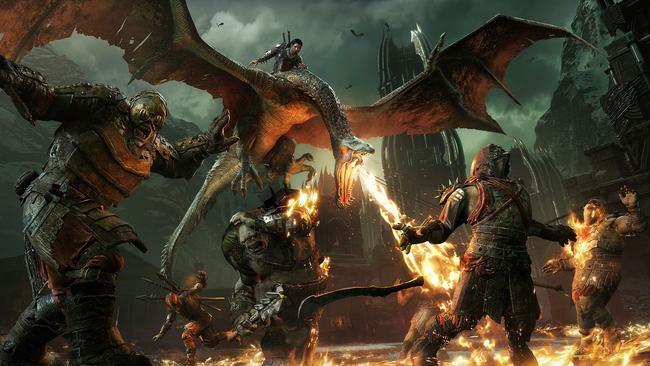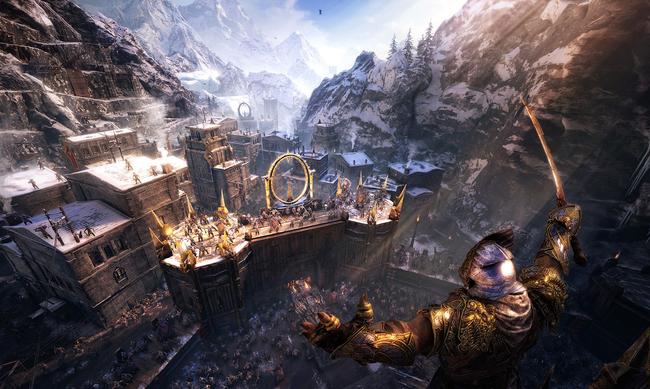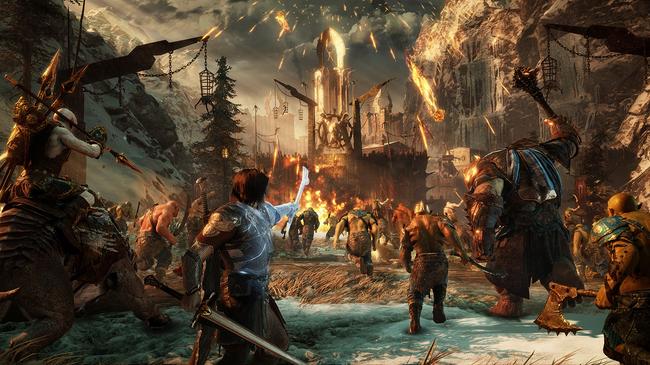
Middle-Earth: Shadow of War Review
The world of men is ending. After the Black Hand was defeated in the cataclysmic close to Middle-earth: Shadow of Mordor, Talion cast his gaze at Mount Doom and declared his intent to forge a new Ring of Power. And, that’s precisely where Middle-earth: Shadow of War begins.
When the ring's creation unexpectedly separates Talion from Celebrimbor, the giant spider Shelob takes this chance to capture the ethereal spirit. After immediately rushing headlong into her lair, Talion all too eagerly barters the ring with her for his release. After all, the wraith of the Elf Lord had once saved the Rangers of Gondor captain's life.
It won’t come as a surprise that Middle-earth: Shadow of War regularly makes a song and dance about the New Ring - as it is unimaginatively referred to on repeat occasion. The game’s opening act sees it remain in Shelob's possession where, intermittently granted her prophetic visions, Talion races to defend Minas Ithil after it falls under siege from Sauron’s forces. Once it is eventually recovered, the New Ring gives you the power of Domination over your enemies. But, more on that later.

The first act plays out more as a tutorial than anything, gently introducing the player to the game’s intricate web of mechanics before everything steps up a notch as you move into the second act. It will prove to be familiar ground for those that took on the Black Hand in Middle-earth: Shadow of Mordor, but developer Monolith Productions has worked to heavily expand on what came before.
Every mission that you undertake on your quest to reclaim Mordor will reward you with experience that, unsurprisingly, will allow you to level up. This hands you a skill point to allocate, a broadened skill tree letting you choose whether to focus on Talion’s prowess in areas such as combat, stealth, and Wraith attacks. Early on that will see you unlock base skills that will let you execute your enemies, throw daggers in their direction, and pin them in place with arrows, but, in turn, each skill also has its own upgrades to consider that will make you an even greater force to be reckoned with in the midst of battle.
When you do clash blades with the green skin horde, there are three bars to keep in mind: Focus can be used to speed your traversal around Mordor and, more specifically, relates to your ranged attacks; Might is slowly built with successful attacks and is used to perform brutal executions; and Wrath, which is built by killing enemies, can be spent to active Elven Rage - a devastating flurry that will see you mercilessly hack at your enemies and rain arrows in all directions.

It can easily be seen that Middle-earth: Shadow of War thrives in combat, even if echoes from the Batman: Arkham series linger. The more time that you sink in, the broader it becomes. That comes in skill upgrades that, for example, let you instantly kill any orc after performing a perfect counter, slow time in mid-air so that you can let loose with arrows to feel as slick as Legolas all over again, or summoning mounts to your side - drakes being the most impressive as you unleash a fiery death upon your foes from the skies above.
As you become ever more battle-hardened, there is a gear system at play that will let you upgrade your sword, dagger, bow, armor, cloak, and ringcraft. This is crucial as you progress, letting you deal more damage as enemies become stronger as well as taking more hits whenever you are caught out. Most gear comes from taking out Epic and Legendary Orcs as well as mission rewards, and, if it isn’t obvious, the Legendary gear is usually the best of the bunch. There are 10 Legendary Sets to accumulate, with bonus effects available to those that choose to wear multiple gear from a specific set. And then, Rare, Epic, and Legendary gear have challenges that can be completed when equipped to increase their level - presenting the chance to strengthen Talion even further.
That isn’t to say that it’s all about locking swords, though. There is as much reward in playing stealthily, whether that be leaping on orcs from above, picking an enemy off from afar with a headshot, or poisoning grog and patiently waiting for nearby orcs to become parched. The skill tree supports this approach too, presenting the chance to chain multiple executions or enhance your poison to make those that drink it become berserk - attacking anyone in sight. If there’s one area that the game unquestionably excels, it’s in allowing you to play in whatever style that you wish.

It’s a shame, then, that most missions are a particular bore. Follow this character. Take out these enemies. Race to this location before the countdown runs out. We’ve done it all before, and it isn’t long before repetition sets in. There are exceptions to this that I’d rather not spoil, in placing the player in set pieces that are exhilarating to be part of. But, these are few and far between. This sentiment is mirrored in the story, which lacks any overarching cohesion. However, the narrative was able to pique my interest in learning more about the Nazgûl as well as the spirit of Carnán, and there is a climactic moment that completely blindsided me that awaits those that see the story through.
Between missions, you are free to spend your time exploring Mordor. There are five regions to explore in Minas Ithil, Cirith Ungol, Seregost, Núrnen, and Gorgoroth, that each come packed with stuff to do. Purifying the Haedir towers is usually the best thing to tackle first, as they can be used to discover lost secrets and memories of Mordor’s past in each region. That will let you mark Shelob Memory, Ithildin, Gondorian Artifacts, and Barrow locations, that act as collectibles to busy your time with - perspective puzzles that see you align the shattered fragments of a memory, words that let you form poems to unlock Ithildin doors to retrieve powerful gear, and artifacts that will let you learn about Gondorian history. They’re a welcome distraction from the main event, and there is just the right amount to gather.
And, then there’s the returning Nemesis System. This much-touted mechanic places importance on every orc that is in the game. If a grunt manages to kill you they can become a Captain, with the hierarchy above them including Warchiefs and Overlords. There is a constant tussle for power, and this can either work to your advantage or disadvantage. With animosity at play, taking each other out can result in their rank increasing which can reward you with a chance to secure higher-level gear whenever they are defeated. But, this also risks that they become a far stronger warrior than you can overcome. As you progress later in the game, encounters can quickly become brutal with multiple Captains appearing at once - odds that aren’t always in your favour.

On that note, each Captain is sprinkled with their own personality and introduce themselves as you prepare to carve each other to pieces - Rûg the Bard being a personal favourite. But, this eventually becomes a frustration. When you turn the corner to see three or four Captains, you may as well throw the controller to one side as they wax lyrical about crushing your skull in. It breaks the flow of gameplay and, as far as I can tell, there’s no way to skip past them. And then, to make matters worse, any time that a Captain becomes enraged, the camera pans to them momentarily to flag what’s happening. It’s odd to me that the developer didn’t recognise how much of a disruptive distraction this can become, a repeated annoyance, especially in larger-scale brawls.
In essence, the Nemesis System is structured the same way as before with more variety thrown in for good measure. Interrogating Worm enemies will let you gain intel on a Captain’s strengths and weaknesses, exploiting their vulnerabilities making them far easier to take down. This is soon expanded, with the player able to use Worms to deliver death threats to create a Nemesis Mission - increasing a Captain’s level, with the chance for more lucrative rewards. Higher-level Captains will have Traits that are worth keeping an eye out for, whether that be a powerful weapon or ability to heal themselves - factors that can influence how the player approaches them. And, while Captains can escape, when killed they could still cheat death to face you once more, or their blood-brother could randomly seek you out for revenge. It makes the game come alive, even if issues are still present.
Where Middle-earth: Shadow of War excites most is when you’re leading your forces in a large-scale assault to capture an imposing fortress. There really is nothing like it. This is where the New Ring comes in - the player choosing to recruit Captains, whose spirit they break in battle, to their army. Build your army and it’s more likely that, with the help of your Captains, the assault will succeed. It’s something that you will do throughout your time in Mordor, with the story frequently encouraging it. It is important to point out that you have a separate army in each region, and, in order to strengthen their individual assault force level, you must recruit more Captains and buy Siege Upgrades - whether that be explosive sappers that charge the fortress gates, Olog-hai to destroy fortress walls, or mounted cavalry in caragor riders. And, when ready, the assault begins.

After charging the wall and climbing over, you must fight to capture specific points and take out any Warchiefs to push back your enemy. Your ultimate goal is to decapitate the Overlord in the central keep in order to take control of the fortress. If you want to make the assault easier, you can take on an optional Confrontation Mission to lure a Warchief out that, when killed, will see their defensive bonus removed.
It doesn’t end there either, with the player then having to deal with defending their fortress from any attacks that, understandably, sees the roles reversed. This will see you buy Siege Upgrades to reinforce the walls, pour toxic gas from them, or position caged drakes at gates to blast anyone that comes near them with their fiery breath. You can only buy such upgrades and not have the chance to choose where to position them, but upgrading a fortress to near impenetrable status is incredibly satisfying.
There’s some purpose to it all away from the story, too. You can choose to attack or defend another player’s fortress online, presenting another chance to improve your rank and earn yourself rewards if successful. Seeing as it’s pre-launch I haven’t found any that were particularly troublesome, but this is an area where Middle-earth: Shadow of War heroically shows the most promise.
There has been some controversy around the Market, a place where players can spend Mirian and Gold to buy chests from The Headhunter. These contain powerful gear, temporary boosts, orcs that can be assigned to your army in any region, and training orders that can upgrade your Captains with better weaponry. Not once have I felt the need to ever spend real-world money in it, which makes me question why it even exists in the first place - I certainly didn’t have as much issue with the relentless siege battles in the fourth act as others have.
Middle-earth: Shadow of War resoundingly beats to the sound of its own war drum to result in an experience that is iterative rather than revolutionary. Bold and resolute, its strength in character stirs when leading the charge into battle to create sweepingly epic moments that thrill in their dark and violent chaos. It’s a promising return to Tolkien’s world, even if the journey isn’t without its meandering fumbles.